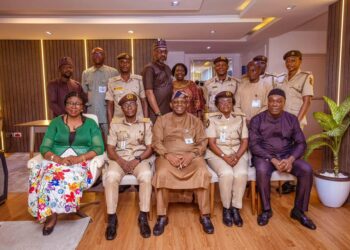The Managing Director of the National Port Authority of Liberia, Ms. Matilda Parker has changed her earlier position on the US$120 million agreement signed between the Government of Liberia and the APM Terminal to modernized and managed the Freeport of Monrovia for 24 years.
Madam Parker had first told the House and Senate Committees on Public Procurement and Concession Commission, State Enterprise, Contract and Monopoly and Judiciary, that the contract did not address the plight of the employees and had serious security implications on the nation.
The MD also raised the issue of loses in revenue generation following the taken over of the port by APM Terminal. She called on the lawmakers to properly scrutinize the agreement before its ratification.
Few days after her assertion at the Capitol Building, the Executive Mansion released a statement that the President will dismiss anyone who publicly differs with the position of Executive Branch of Government on national issue.
But in her testimony on Tuesday before the Joint Legislative Committees, Madam Parker said the …"the Government of Liberia, our only share holder has made a policy decision to move forward with this agreement, and will work through the Board of Directors and the Management of the NPA to ensure that port reform succeed and that the national interest including, the right of the workers are protected, thank you."
But when quizzed by Senator Adolphus Dolo of Nimba County if the agreement was in the best interest of the country, Madam Parker said she stands by the agreement as Managing Director of the NPA, but remains unclear as to her personal position on the matter. Madam Parker also informed the committees that the NPA will lost portion of it current revenue following the take over of the port by the concessionaire.
Senator Dolo however frowned on technicians of the government of not properly informing the President of the flaws in the agreement. He added that the agreement has the propensity to create future problem for the country.
Kenya Considers Bids For New Port
Kenya’s Ministry of Transport has called for bids to construct a new port at Lamu on the northern coast of Kenya.
The advertisement carried by local newspapers states that the new port will initially consist of three deepwater berths capable of taking container ships with a deadweight of 100,000 tonnes, general cargo vessels with a dwt of 30,000t and bulkers of up to 100,000-dwt.
The objective of a new port at Lamu is to better serve South Sudan and southern Ethiopia, and the contract calls for the construction of other supporting infrastructure including roads, a railway, railway sidings, pipelines, and even airports in major towns extending inland.
‘As first phase of this project, the Government plans to construct the first three berths with associated infrastructure at Manda Bay, Lamu,’ the advertisement reads.
It is assumed that Kenya has been in discussion with its neighbours with regards the future use of a new port at Lamu, and in particular with South Sudan which faces a referendum early next year to decide whether to secede from the rest of Sudan. South Sudan expects to begin exporting oil shortly and will require a secure outlet to the sea.
The cost to build the port is estimated at US$ 16 million.
The proposal to build the new port has however drawn some strong opposition particularly from environmentalists but the government has made clear its intention of pressing ahead.
Tension Brews Between China And Japan Over Seized Ship
China has demanded that Japan “unconditionally” frees the captain and crew of a fishing boat it seized in disputed waters.
China’s foreign minister summoned the Japanese ambassador to Beijing for a third time to make a formal protest.
The Chinese trawler collided with two Japanese patrol boats last Tuesday near islands in the East China Sea that are claimed by both China and Japan.
Beijing says it is sending a law enforcement ship to the area.
The foreign ministry said this was to safeguard order in the fishing zone and protect the safety of Chinese fishermen and their assets, according to local media.
The exchange of protests between China and Japan has something of the air of a ritual.
For now, neither country seems to want to dramatise the incident.
But the episode illustrates the underlying tensions in the region where competing claims for small island territories reflect major strategic and economic issues.
Oil and gas rights could be valuable assets for the future.
But the continuing maritime tensions between China and its neighbours reflect a growing desire by the Chinese to pursue a more expansive naval strategy and to break out from the containment of the island chains that stretch from Japan to Taiwan and well into the South China Sea.
The area is close to uninhabited islands, known as Senkaku in Japan and Diaoyu in China, which are controlled by Japan, but are also claimed by China and Taiwan.
In recent years, Chinese activists have sailed to the islands on a number of occasions to assert China’s territorial claims.
The Japanese suspect the Chinese vessel deliberately rammed the Japanese boats, and are deciding whether to charge the captain.
There were no injuries, and the two Japanese vessels sustained minor damage.
Beijing has warned of a “serious impact” on relations if the situation is not resolved.
China’s Foreign Minister Yang Jiechi told the Japanese ambassador that “the Chinese government’s determination to safeguard the sovereignty of the Diaoyu islands and the nation’s people is firm and steadfast”.
It comes a day after China’s foreign ministry described Japan’s handling of the incident as “absurd, illegal and invalid”.
Analysts say this latest incident is unlikely to disrupt Japan-China ties but it underscores the inevitable tensions as China’s maritime ambitions grow.
Cash-Strapped Dubai World Sets To Sell DP World
Ongoing reports are suggesting that the financially troubled Dubai World is ready to sell off some of its prized assets, including the port operator known as DP World.
In August it was suggested that Dubai World, which needs to get its hands on some ready cash or find other ways of restructuring a debt reported to be totalling US$ 39.4 billion, was prepared to sell not only DP World but the Jebel Ali Free Zone and Dubai Maritime City in order to raise $19.4 billion for its creditors by 1 October 2010.
One school of thought says that the offer to sell these prized assets might simply be a message of assurance that Dubai World possesses the means of settling debts and some analysts considered that it was not necessarily an indication of any definite sales going forward.
Initially Dubai World said that assets such as DP World (its terminal and port operating division) and Dry Docks World (primarily the Dubai Dry Docks) would be excluded from debt restructuring, as both are seen as intricate parts of the emirate itself. Only in a worst case scenario would Dubai World sell off a majority stake in either, they suggested. Other divisions of the state-owned entity such as equity division Istithmar, which controls a majority stake in Cape Town’s V&A Waterfront, were instead being looked at to raise much of the necessary capital.
Another alternative is for Dubai to turn once more to oil-rich Abu Dhabi for a bail-out. Whatever it does, Dubai World is sitting in a tight spot and that means by extension the emirate of Dubai is in a tight spot as well. And as the 1 October draws closer so also do the options become less.
Locally, DP World has a sizeable stake in the port of Maputo and in South Africa it owns a stevedore section trading as DP World Cargo Services – the former P&O Ports. Other Africa region divisions include the Doraleh Container Terminal at Djibouti, the port of Dakar in Senegal and container terminals in Tangier and Djen Djen, Algiers.
SDV’s Mombasa Dry Port Terminal Ready in October
SDV Transami’s new dry port in Mombasa will open in October, according to Transnami’s regional managing director Tony Stenning.
The dry port will help ease ongoing congestion in the port of Mombasa, said Stenning. “With Kenya’s growing economy, there is need for the Port of Mombasa to become more competitive by increasing its efficiency. The intention is to have the new terminal as a holding ground that will ease congestion there.”
In 2009 Mombasa handled a total of 620,000 TEUs, well in excess of its planned capacity which placed the port and terminal under severe pressure. The new SDV dry port terminal is expected to help relieve that pressure ahead of completion of new berths and a planned second container terminal at the port.
Mombasa acts as a gateway port for not only Kenya but also neighbouring Uganda, South Sudan, Rwanda, Burundi and the eastern DRC. Last year the port was forced to handle a considerable number of transhipment containers, some of them intended for the Tanzanian port of Dar es Salaam which were redirected to Mombasa because of ongoing congestion at the Tanzanian port.
The new dry port terminal cost SDV, which is a division of the French Bollore Group, KSh700 million (US$ 8.65m) to construct.
















Discussion about this post